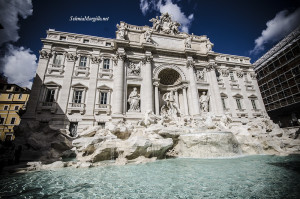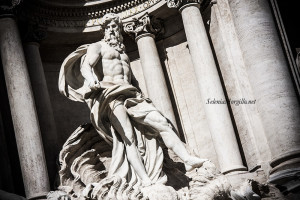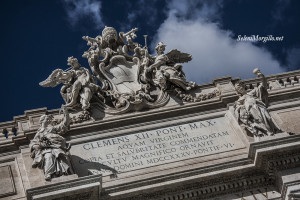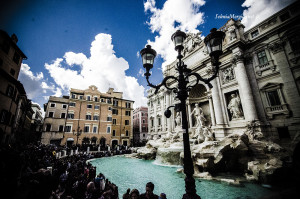La “dolce vita”: Trevi Fountain
Italian Version below*
Leaning against the front of Palazzo Poli (headquarters of the National Institute of Graphics), Trevi Fountain is among the symbols that best identify Roman Dolce Vita and Baroque Rome. Set of very famous films, from Federico Fellini’s Dolce Vita to Totò Truffa 62 by Camillo Mastrocinque, at Tre Soldi in the fountain Jean Negulesco.
The fountain built in the eighteenth century is powered by the very ancient Virgin Aqueduct, the sixth Roman aqueduct and the only one still functional, created by Marco Vipsanio Agrippa, a faithful friend and general of Ottaviano Augusto, inaugurated in 19 BC.
The fountain has been called Trevi since Renaissance because positioned in the center of a Trejo-Trivio road; it was built at the behest of Clement XII on a project by Nicola Salvi who began the work in 1733 but was unable to see the completed design.
The official inauguration took place only in 1762 by Pope Clement XIII and the works were completed by Giuseppe Pannini with some changes compared to the original project.
An obligatory destination for all tourists visiting Rome, the Fountain has a height of 32 meters if we consider the tiara at the top of the heraldic commemorative coat of arms of Pope Clement XII; every day it pours about 80,000 m3 of water.
At the center of the sculptural decoration, by Pietro Bracci, appears Oceano which holds the distinction of being the largest sculpture in Rome with its almost 6 meters, on a shell-shaped cart pulled by two sea horses led by two tritons; laterally in two niches the statues of abundance and Health.
The 2 reliefs, placed in the central register, recall the episodes of: “Agrippa observing the project of the Virgin Aqueduct” and “The Virgin indicates the source to thirsty soldiers”.
The papal coat of arms, visible at the top centrally, is the work of Paolo Benaglia and is surrounded by Four Female Statues indicating the Four Seasons: theAbundance of Fruit, the Fertility of the Fields, the Riches of Autumn and the Amenity of the Meadows and Gardens.
Among the curiosities related to the Fountain, the most famous is certainly the launch of the Monetina (coin); auspicious gesture for a return to Rome.
Another curiosity is the ornamental vase, called Asso di Coppe for its shape, positioned laterally to the right, right by Salvi to remedy the criticisms of a barber disturbed by the din of the Fountain during its construction.
Finally, the tradition of making people drink a girl to her boyfriend who leaves for military service, a glass of water from the fountain, then breaking the glass to symbolize that the boy will not be able to forget her.
Perhaps not everyone knows that … it is possible to admire part of the Virgin Aqueduct?
Info… HERE & Rinascente Rome
Info Site: Piazza di Trevi
Metro A Barberini or Spagna stop
All rights reserved*
Addossata alla fronte di Palazzo Poli (Sede dell’Istituto Nazionale della Grafica), Fontana di Trevi è tra i simboli che meglio identificano la Dolce Vita Romana e la Roma c.d. Barocca.
Set di famosissimi film, dalla Dolce Vita di Federico Fellini a Totò Truffa 62 di Camillo Mastrocinque, a Tre Soldi nella Fontana di Jean Negulesco.
La Fontana realizzata nel XVIII secolo viene alimentata dall’antichissimo Acquedotto Vergine, sesto acquedotto romano ed unico ad essere ancora funzionante, realizzato da Marco Vipsanio Agrippa fedele amico e generale di Ottaviano Augusto, inaugurato nel 19 a.C.
La Fontana è detta di Trevi dall’epoca rinascimentale, perché posizionata al centro di un Trejo-Trivio di strada; fu realizzata per volere di Clemente XII su progetto di Nicola Salvi che iniziò i lavori nel 1733, non riuscendo però a vederne il disegno compiuto.
L’inaugurazione ufficiale, si ebbe solo nel 1762 da Papa Clemente XIII ed i lavori furono terminati da Giuseppe Pannini con alcune modifiche rispetto al progetto originario.
Meta obbligata per tutti i turisti che visitano Roma, la Fontana ha un’altezza di 32 metri se consideriamo la tiara al vertice dello stemma araldico commemorativo di Papa Clemente XII; ogni giorno versa circa 80.000 m3 di acqua.
Al centro della decorazione scultorea, opera di Pietro Bracci, appare Oceano che detiene il primato di essere la più grande scultura presente a Roma con i suoi quasi 6 metri, su un carro a forma di conchiglia trainato da due cavalli marini guidati da due tritone; lateralmente in due nicchie le statue dell’Abbondanza e della Salubrità.
I 2 rilievi, posti nel registro centrale, ricordano gli episodi di: “ Agrippa che osserva il progetto dell’Acquedotto Vergine” e “La Vergine indica la sorgente ai soldati assetati”.
Lo stemma papale, visibile in alto centralmente, è opera di Paolo Benaglia ed è contornato da Quattro Statue Femminili indicanti le Quattro Stagioni: l’Abbondanza della Frutta, la Fertilità dei Campi, le Ricchezze dell’Autunno e l’Amenità dei Prati e dei Giardini.
Tra le curiosità legate alla Fontana la più famosa è sicuramente il lancio della Monetina; gesto di buon auspicio per un ritorno a Roma.
Altra curiosità è iI vaso ornamentale, detto Asso di Coppe per la sua forma, posizionato lateralmente a destra, proprio dal Salvi per ovviare alle critiche di un barbiere disturbato dai frastuoni della Fontana durante la sua realizzazione.
Infine, la tradizione di far bere da una ragazza al fidanzato che parte per il servizio militare, un bicchiere di acqua della Fontana, rompendo poi il bicchiere a simboleggiare che il ragazzo non potrà scordarsi di lei.
Forse non tutti sanno che… è possibile ammirare parte dell’Acquedotto Vergine?
Info… QUI
Info Site: Piazza di Trevi
Metro A Fermata Barberini o Spagna
Sostieni la #culturachevince, aiuta la condivisione.



